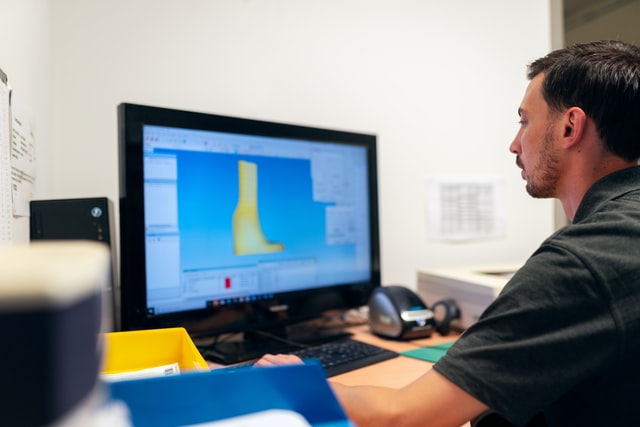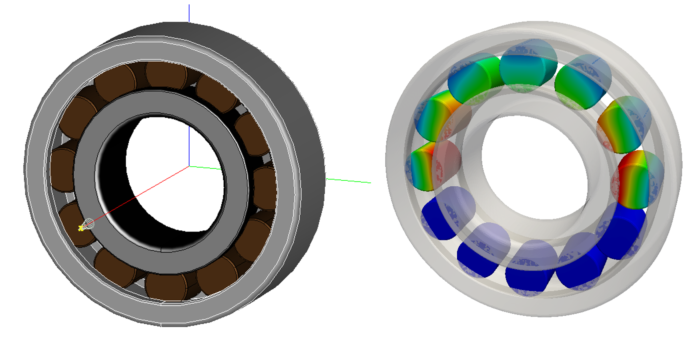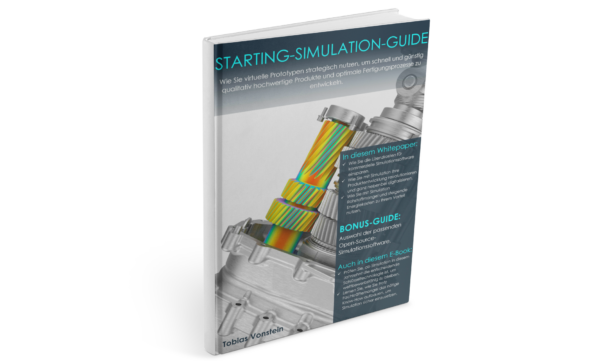Industry 4.0 is on everyone’s lips and is discussed in countless specialist publications. That is good, because Industry 4.0 stimulates thinking about the processes in your own product creation process. Terms such as digital twin, virtual prototype and simulation are in circulation and must be filled with a meaning that is as uniform as possible. In this blog post we would like to give you an overview of the meaning of these terms and build a common understanding. The discussion about Industry 4.0 is by no means aloof and academic. It sums up the industrial application of digital transformation, also in small and medium-sized companies.
Industry 4.0 is driving digitalization in the product creation process
It is to be expected that the development of new interface standards and a separate language for the communication of the digital twins will have very practical effects for SMEs in the near future. To understand the scope of this development, you only need to think, as an example, of how natural it is for designers to download CAD files for purchased parts today. In the past, the catalogs of the manufacturers of machine components such as screws, valves and safety switches were enough for him. Today he naturally expects to find the CAD files of these machine components for download on the Internet so that they can be copied into his own CAD models. Manufacturers who do not offer the CAD files of their products for download in known formats such as IGES, STEP and VDA-FS are in a difficult position. A similar development can be expected in Industry 4.0. Only those who are able to let their own digital twins, virtual prototypes and simulation models communicate with those of other manufacturers and customers will stay on the ball.
Concerted action creates clarity – Industry 4.0 platform
Under the leadership of the Federal Ministry for Economic Affairs and Energy , the Federal Ministry for Education and Research and a number of well-known industrial associations and companies, the Industry 4.0 platform is developing a comprehensive range of information and strategies for the digital transformation of production in Germany. Based on the Industry 4.0 platform and other sources, we give here our understanding of the terms digital twin, virtual prototype and simulation. Our presentation does not claim to be complete or general, but is intended to make it easier for you to read our articles.
Differences between digital twin, virtual prototype and simulation model
Digital twin
As we understand it, the digital twin is a data container, also known as an administration shell. It stores the data that is collected in the course of a product life cycle. The storage takes place in so-called partial models. Each partial model stands for the data of a specific application that is generated for the development, production, sales and maintenance of a product. The digital twin is a virtual model of the real product. It differs from the virtual prototype in the additional data stored for the manufacture, use and maintenance of the product and its individual instances.
Virtual prototype
As a virtual prototype, we understand the counterpart to the real prototype. The virtual prototype is a digital model of a machine part or product. In addition to the CAD geometry, it can include one or more simulation models. Depending on the level of detail of the virtual prototype, simulation models for mechanics, thermodynamics, flow and many other physical subjects can be assigned. The virtual prototype is a partial model of the digital twin.
Simulation model
The simulation model consists of the geometric model, the selected physical laws, the settings for the calculation and many other parameters. In addition, there are the calculation results, if necessary data for validation and records of the evaluations and derived measures.
Simulation methods – tools for creating virtual prototypes
In digitized product development, virtual prototypes are intended to replace real prototypes in order to save costs and enable early, reliable decisions. Simulation methods such as FEM, CFD and MKS are tools for creating virtual prototypes in product development. Even if they are not referred to as virtual prototypes in everyday language within a company, they are often already there in the form of CAD files, simulation models and other records. Illustration – … Like their real counterparts, virtual prototypes have to be created with tools. The tools for creating virtual prototypes are provided by the simulation methods. They contain data on geometry, material, boundary conditions, loads, applicable physics (mechanics, temperature, vibration), settings for the calculation (step sizes, number of CPUs, termination criteria), calculation results, comments and much more individual information for the virtual prototype to create and manage. Simulation methods map the physical behavior of a virtual prototype by solving the systems of equations after the model has been created. In the following sections, we’ll give you a brief overview and we’ll look at some of these methods in more detail in upcoming blog posts .
Collision check in CAD
An early field of application of virtual prototypes was the collision check of components in CAD. The CAD models of side-by-side components were checked for penetration and assemblability to ensure they had enough space. This already represents a simple form of simulation with virtual prototypes. It could be carried out long before the completion of real prototypes and offered enormous cost advantages.

FEM in solid mechanics
The finite element method (FEM) is one of the best-known numerical methods for solving systems of equations in solid mechanics and other fields of engineering. It was first used in research and in large companies in the 1960s. Since the advent of powerful desktop PCs in the 80s, FEM has been widely used in mechanical engineering, process engineering, civil engineering and many other industries. Numerous physical phenomena and laws from mechanics, thermodynamics, vibration theory and other disciplines are mapped in the FEM and can be called up in the available FEM solutions. A large selection of FEM software is available in the form of commercial products and open source solutions (OSS). The process of an FEM application is divided into model creation (preprocessing), calculation run and result evaluation (postprocessing). The programs available today offer many functions for quick model creation. The learning curve for users is steep because working on their own range of products enables them to concentrate on a manageable selection of program functions.
CFD and FSI for flow simulation
Computational Fluid Dynamics (CFD) is an independent subject of simulation methods for flow simulation. Flow simulation uses Navier-Stokes equations, Euler equations, potential equations, and other systems that are solved using various numerical methods. For a long time, CFD was considered a topic with very high demands on the physical understanding of users and computer performance. In the meantime, CFD systems with comfortable user interfaces have been developed that support designers in many everyday simulation tasks. They run on the hardware customary in the design office, but also enable arithmetic runs on mainframes. With the connection of CFD and FEM fluid-structure-interactions (FSI) are to be investigated.
MKS / EMKS multi-body simulation
The multi-body simulation (MBS) is not quite as visually impressive, but no less important in practical use. In MKS, arrangements of rigid solids are considered almost independently of their real geometry. The aim is to investigate the kinematic system that the greatly simplified bodies form together with idealized articulations. The movement of the multibody systems is described by differential equations that are solved on the computer. If the elastic behavior of a solid cannot be neglected, it is called an elastic multi-body system (EMKS). It can be investigated with a coupling of the methods of MBS and FEM.

Digital twins, virtual prototypes and simulation models in industrial practice
In the simplest case, a virtual prototype is already mapped by a single simulation model and is used to clarify the open questions. A virtual prototype, which is used for a simple FEM simulation with a linear-elastic material law, can provide crucial information on the suitability of the design at an early stage in the product development process. Of course, a virtual prototype can also consist of several simulation models in order to capture different aspects of the physical behavior. One example is the virtual prototype of a machine tool with an FEM simulation model for the deformation of the frame, an MBS model for the dynamic behavior of spindle, tool, workpiece, drive and gear and a CFD model for cooling the process with cutting fluid.
Simulation models are an essential part of the digital twin
The digital twin is to be understood as a universal data container that accompanies a product type and its individual instances through the life cycle. It can contain one or more sub-models that are assigned to specific applications, such as a simulation program. If a simulation model is made for a calculation, such as for the linear-elastic simulation of a machine lever, a partial model is available in the digital twin for storing the input data and calculation results over the entire product life cycle. The attentive reader will wonder why simulation models are an “essential” part of the digital twin. From our point of view, the answer is quite simple: The simulation of the reaction of a machine component or virtual prototype turns a mere collection of data into a living object in virtual space. Its behavior in response to external and internal stresses can be studied with almost any degree of accuracy. The user turns from data collector to observer and gains deep insight into the functioning of the virtual prototype. Therefore simulation models are essential for the use of the digital twin.
Simulation models form the foundation for the virtual prototype
Simulation models form the basis for the virtual description of the physical properties of products and manufacturing processes. The description of the physical properties takes place in simulation models not only via individual parameters, but also via virtual functions, i.e. calculation runs that examine the physical behavior of the product and reproduce it in a way that is understandable for the observer, ie visually. The simulation is about the behavior of the virtual prototype, not just about rigid physical values such as color, height, weight, speed and connector type.
How do you see the role of simulation in the context of digitization and Industry 4.0? How do you understand the terms digital twin, virtual prototype and simulation model? We look forward to your feedback!



What a brilliant article Tobias Vonstein.
I can only agree with the statement” “Terms such as digital twin, virtual prototype and simulation are in circulation and must be filled with a meaning that is as uniform as possible”. I love this.
I think that thanks to your article, we will better understand publications that use these terms.
Thank you Tobias for putting that together, great educative work avec very useful for the simulation community.
Thank you very much for sharing and for your valuable Feedback Dominique. As I can read, we achieve the goals we had with this one. There is much more to come in the next weeks. All German articles will be translated in English for the worldwide simulation community. I am excited for the feedback of you and the simulation community.
Nice overview. I might have liked to see a brief comment about exploiting the cloud and mobile devices (which are a cornerstone of the fourth industrial revolution) into the whole digital twin workflow.
Thank you very much for your feedback. My view of the topic comes more from the direction of the simulation model and the role of simulation in industry 4.0. But you are right. For example cloud computing is also a very important topic for simulation and simulation democratization. We will add this aspects with the next update.
excellent!!! even after going through several lectures/seminars, I couldn’t make out clear mind map on Digital Twin but indeed the article helped me figuring out blue-chip & diving into the arena of I4.O.
Thanks.
I am satisfied to hear our article helps you to make out a clear mind map on digital twin. This was our goal!
I really appreciate your feedback.